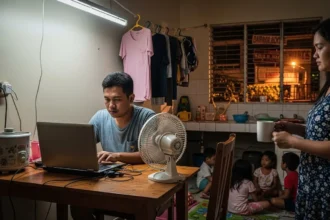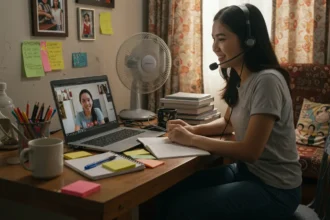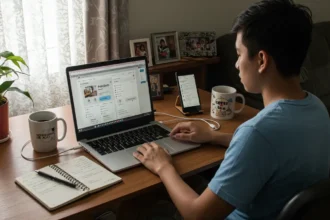Freelancing has become one of the most exciting career paths for Filipinos today. But many beginners still wonder: how to start freelancing in the Philippines without experience? For those who’ve never worked online, it can feel intimidating – “Wala pa akong portfolio, wala pa akong skills, baka walang kumuha sa akin.” The truth is, every successful freelancer started exactly where you are now: with zero experience.
- 💡 Step 1: Identify Your Strengths and Marketable Skills
- 🛠️ Step 2: Learn and Build Basic Samples
- 🌐 Step 3: Choose the Right Freelancing Platform
- 📑 Step 4: Write a Simple But Strong Proposal
- 📈 Step 5: Start Small, Then Grow
- 📅 30–60–90 Day Roadmap for Freelancing Beginners
- FAQs
- 🌏 What This Means for Pinoys Starting Freelancing
In 2025, freelancing isn’t just a side hustle anymore – it’s a real career option for Pinoys. You don’t need to leave the house, deal with traffic in EDSA, or even have a degree in IT to get started. With the right strategy, a bit of diskarte, and consistent effort, you can land your first client online and build a career that grows month after month.
This guide will walk you through practical steps for Filipinos to start freelancing even without prior experience – from choosing the right skill to creating samples, finding your first client, and avoiding scams.
💡 Step 1: Identify Your Strengths and Marketable Skills
The most important step in starting your freelance journey isn’t creating a profile or applying for random jobs; it’s taking a moment for a self-audit to understand the valuable skills you already possess. Many aspiring freelancers get stuck here, thinking they have “no experience.” The reality is, you have a lifetime of experiences and skills that, when framed correctly, are highly marketable online.
The Self-Audit: What Can You Offer?
Before you even look at a job posting, ask yourself these questions. Don’t worry about sounding “professional”-just be honest.
- What are my hard skills? These are teachable abilities. Think about software you know how to use (even just the basics of Microsoft Word, Excel, or Canva), languages you can write in, or any technical skills you’ve picked up in school or as a hobby.
- What are my soft skills? These are your personality traits. Are you extremely organized? Are you a great communicator? Are you patient and empathetic? Are you creative and full of ideas? These are the foundation of great service.
- What do I enjoy doing? Your hobbies and passions are often a goldmine of marketable skills. Do you love organizing your photos, planning trips, writing in a journal, or creating graphics for a fan page? These can all be turned into paid services.
A Closer Look at Beginner-Friendly Skills
Let’s break down the most common entry-level freelance jobs and the simple, everyday skills they require.
1. Virtual Assistance (VA): The Ultimate Organizer This is one of the most in-demand roles for beginners because it relies heavily on organizational and communication skills. If you can manage your own schedule, you can likely do it for someone else.
- Core Tasks: Scheduling meetings in Google Calendar, handling and organizing emails, doing online research (e.g., finding the best flight deals or potential sales leads), basic data entry in Google Sheets, and other administrative tasks.
- You’re a good fit if: You’re the “planner” in your friend group, you have a color-coded schedule, or you’re great at keeping track of details.
2. Writing: The Everyday Communicator You don’t need to be a novelist to be a freelance writer. Many businesses need simple, clear, and engaging text for their online presence.
- Core Tasks: Writing short blog posts, creating captions for social media, writing simple product descriptions for e-commerce sites like Shopee or Lazada, or proofreading documents for errors.
- You’re a good fit if: You enjoy writing, you’re the one your friends ask to check their grammar, or you can explain things clearly and concisely.
3. Graphic Design: The Visual Creator With free and user-friendly tools like Canva, graphic design is more accessible than ever. You don’t need to be a Photoshop expert to create valuable visual content.
- Core Tasks: Creating social media graphics for Facebook and Instagram, designing simple logos for small businesses, making posters for online events, or creating templates for presentations.
- You’re a good fit if: You have a good eye for what looks nice, you enjoy making things visually appealing, or you’ve ever created a slideshow or poster for a school project that you were proud of.
4. Data Entry & Transcription: The Detail-Oriented Specialist These jobs are perfect for people who are meticulous and have good listening and typing skills. They require focus and accuracy.
- Core Tasks: Copying information from a PDF file into a spreadsheet, listening to an audio or video recording and typing out what is said, or updating customer information in a database.
- You’re a good fit if: You’re a fast and accurate typist, you have a good ear for detail, and you don’t mind repetitive but focused work.
5. Social Media Management: The Community Builder If you’re already active on social media, you can turn that knowledge into a service. Businesses need help maintaining their online presence and engaging with their audience.
- Core Tasks: Scheduling and publishing posts on Facebook or Instagram, responding to comments and messages, finding interesting content to share, and helping to grow a client’s follower count.
- You’re a good fit if: You understand how different social media platforms work, you enjoy interacting with people online, and you know what makes a post engaging.
⭐ Pro Tip: Translate Your Life Skills into Freelance Skills
Think about what friends, family, or teachers already ask you for help with. Those are your proven strengths.
- Did you organize the family reunion or a group trip? That’s event coordination and project management.
- Did you create the PowerPoint presentation for your school group? That’s presentation design.
- Do you help your tita with her small business’s Facebook page? That’s social media management experience.
- Are you the one who finds the best deals on Lazada? That’s online research and product sourcing.
The goal of this first step is to build a “menu of services” you feel confident offering. Start small, focus on what you already know, and you’ll be ready to build your freelance profile with clarity and purpose.
🛠️ Step 2: Learn and Build Basic Samples
Clients don’t always ask for years of experience, but they do want proof of your ability. If you don’t have past clients, create samples to showcase your work.
How to Create Samples Without Clients
-
Writing: Draft a 500-word blog post on a topic you love.
-
Graphic Design: Make three sample Instagram posts using Canva.
-
VA Skills: Create a mock Excel sheet with schedules and data.
-
Social Media: Build a “content calendar” as if for a brand.
These don’t need to be paid projects – they just need to show you can deliver. Upload them on Google Drive or make a simple portfolio in Canva/Notion to share with clients.
🌐 Step 3: Choose the Right Freelancing Platform
Filipinos have plenty of options to find legit freelance jobs. Some platforms are global, others are Pinoy-friendly.
Popular Platforms for Beginners
-
OnlineJobs.ph: Very friendly to Pinoys, focused on VA/admin jobs.
-
Upwork: Global clients, competitive but high-paying.
-
Fiverr: Good for selling fixed packages (like “3 Canva designs”).
-
Freelancer.com: Entry-level jobs, mixed opportunities.
-
Facebook Groups: Many local SMEs look for freelancers here.
Pro Tip: Apply to at least 5–10 jobs daily when starting. Consistency beats luck.
📑 Step 4: Write a Simple But Strong Proposal
A common beginner mistake is sending generic applications. Clients want to know why you’re the right fit.
Basic Proposal Template
-
Greet and mention the client’s project.
-
State how you can help them achieve results.
-
Share 1–2 relevant samples (even self-made).
-
End with a clear call-to-action (“Shall we set a quick chat?”).
Keep it short, clear, and confident. No need to apologize for being new – focus on what you can do.
📈 Step 5: Start Small, Then Grow
Your first project may not pay much, but that’s okay. Think of it as an investment. After your first few clients, you can increase your rates and specialize.
Example Freelancer Growth Path
-
First 1–3 clients: Offer low rates to build reviews.
-
Clients 4–6: Increase rates by 20–30%, add more value (analytics, captions, reports).
-
Clients 7+: Specialize and build a niche (e.g., social media for real estate).
The key is consistency. Even ₱5,000–₱10,000 for your first month online is proof of concept. From there, your growth compounds.
📅 30–60–90 Day Roadmap for Freelancing Beginners
Getting started with freelancing can feel overwhelming, but breaking it down into manageable 30-day milestones helps. Here’s a realistic roadmap that any beginner in the Philippines can follow – even without experience.
Day 1–30: Learn and Build Your Foundations
The first month is all about skills and visibility. You don’t need to know everything, but you need something to show.
Action Plan:
-
Pick one beginner-friendly skill (VA, writing, design, transcription).
-
Spend 1–2 hours daily learning through YouTube or free courses (Coursera, HubSpot, Canva tutorials).
-
Create 3–5 samples: e.g., a blog post, a mock social media calendar, a few Canva graphics.
-
Build a simple portfolio: Google Drive folder, Canva presentation, or Notion page.
-
Join 2–3 freelancing communities on Facebook to see real job posts.
Goal by Day 30: Have a basic portfolio ready and accounts set up on at least one platform (Upwork, Fiverr, or OnlineJobs.ph).
Day 31–60: Apply Consistently and Land Your First Client
The second month is about taking action. Even without reviews, persistence wins.
Action Plan:
-
Apply to 5–10 jobs daily on freelancing platforms.
-
Write personalized proposals (mention client’s project, attach one relevant sample).
-
Accept starter rates (₱100–₱200/hour or fixed small projects) to build credibility.
-
Offer quick turnaround times to impress first clients.
-
Ask for feedback or testimonials after completing jobs.
Goal by Day 60: Land your first 1–3 paid projects (even small ones) and earn at least ₱3,000–₱10,000.
Day 61–90: Raise Rates and Build Momentum
By the third month, you now have real client work under your belt. It’s time to level up.
Action Plan:
-
Increase your rates by 20–30% once you have positive reviews.
-
Specialize: position yourself as “Social Media VA for Real Estate Agents” instead of just “VA.”
-
Create new portfolio samples based on your paid work.
-
Pitch higher-paying clients, focusing on value (e.g., “I help you save 10 hours a week by managing your inbox and schedule”).
-
Start exploring long-term contracts or retainers.
Goal by Day 90: Earn a steady ₱15,000–₱30,000/month from 2–3 consistent clients.
📊 Roadmap at a Glance
| Timeline | Focus | Key Actions | Target Outcome |
|---|---|---|---|
| Day 1–30 | Learn & Build | Choose skill, study basics, make samples | Simple portfolio, platform setup |
| Day 31–60 | Apply & Earn First ₱ | Send daily proposals, accept starter gigs | 1–3 paid projects, ₱3k–₱10k |
| Day 61–90 | Grow & Specialize | Raise rates, niche down, build reputation | ₱15k–₱30k/month, repeat clients |
FAQs
1. Can I start freelancing in the Philippines without any experience?
Yes. Many Pinoys begin freelancing with zero experience by offering beginner-friendly services like VA work, writing, or basic design. The key is creating simple samples to show clients.
2. Do I need a degree to become a freelancer?
No. Most clients care more about skills and reliability than diplomas. Even students and stay-at-home parents have built full-time freelance careers.
3. How much can beginners earn in freelancing?
At first, expect ₱5,000–₱15,000 monthly. As you gain clients and specialize, earnings can grow to ₱30,000–₱60,000+ per month, depending on your niche.
4. What equipment do I need to start?
A laptop (even entry-level), stable internet connection, and basic tools like Google Docs, Canva, and Zoom. Many freelancers begin with just these.
5. Is freelancing safe for Filipinos?
Yes, if you stick to legit platforms. Avoid offers that require “membership fees” or ask you to pay upfront. Always use contracts or milestone payments for new clients.
6. Can students try freelancing?
Absolutely. Freelancing is flexible, making it a great part-time income source for students balancing classes. Many start with small tasks like transcription or social media posting.
7. How do I get my first client faster?
Apply daily, send personalized proposals, and join Pinoy freelancing groups on Facebook for referrals. Even offering free test tasks (short samples only) can help prove your skill.
8. Do freelancers in the Philippines need to pay taxes?
Yes, once your income becomes consistent, you are encouraged to register with the BIR. This makes you eligible for bigger clients and shows professionalism.
🌏 What This Means for Pinoys Starting Freelancing
Starting freelancing in the Philippines without experience may sound difficult, but in reality, it’s all about mindset and persistence. Every expert once started as a beginner. For a student in Cebu, freelancing meant covering tuition without fully relying on parents. For a homemaker in Cavite, it became a way to earn while caring for kids. For an OFW returning home, freelancing offered a chance to rebuild a career locally.
The beauty of freelancing is that it levels the playing field. You don’t need connections, fancy offices, or expensive degrees. What you need is focus, consistency, and willingness to learn. Each small project is a stepping stone to bigger opportunities.
In 2025, as more Filipinos seek better work-life balance and financial independence, freelancing continues to grow as a mainstream career choice. If you’ve been hesitating because you “don’t have experience,” remember: the best time to start was yesterday, but the second best time is today. Your freelancing journey begins the moment you decide to try.










